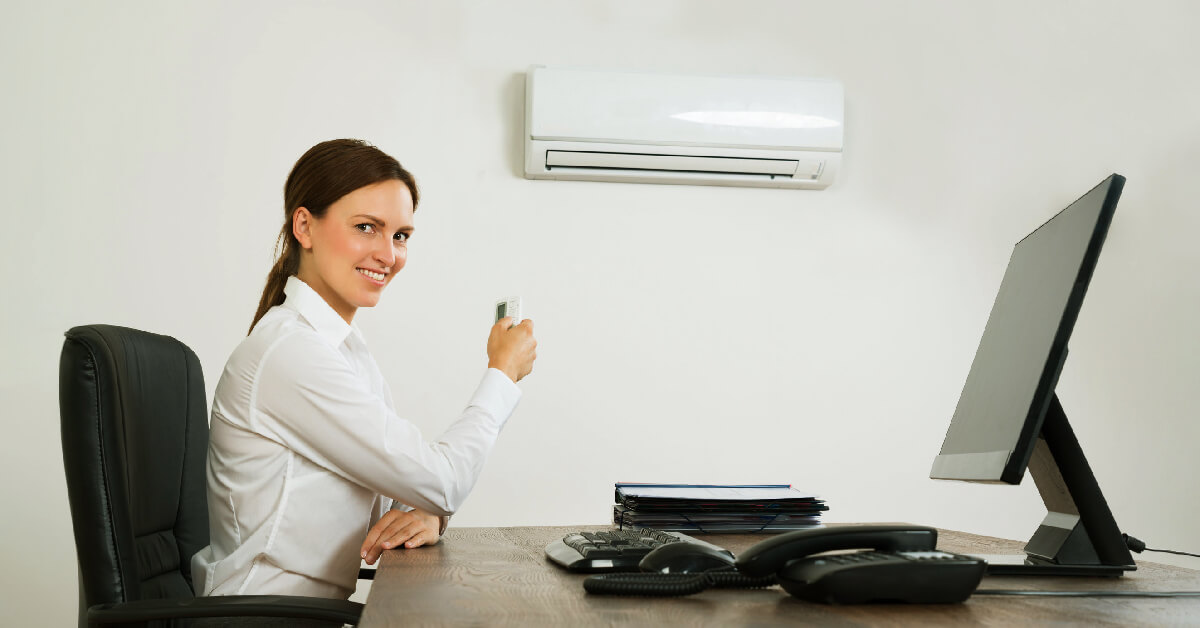The shift to summer brings along the much-needed sunny, warm weather we all have been waiting for after a gloomy winter. But are you aware that too much heat (or too much cold, for that matter) can make you less productive on the job? If the temperature in your office environment causes discomfort, it can impair alertness, focus, energy and workflow. And there’s scientific data to prove it!

In this month’s installment of The Productivity Box, we’re diving into the workspace to uncover the direct link between temperature regulation and overall work performance. Let’s go!
Temperature and workplace productivity
Heat affects the body in many ways. These physiological effects of heat, including headache, nausea, sweat, flushed skin, fatigue or dizziness, can result in occupational stress, according to the International Journal of Environmental Research and Public Health. This can make it difficult for you to concentrate, tune out distractions and finish your tasks.
In fact, another study from researchers at the University of Chicago found that productivity will decline by 4 percent for each degree when the external temperature rises above 80 degrees Fahrenheit. Heat can also increase employee absenteeism, which has negative consequences for business output, revenue and economic gain.
Finally, uncomfortably high temperatures can affect the quality of performance, according to joint research from Harvard and UCLA. In New York City public schools, students are 11 percent less likely to pass an exam in 90 degrees F than they are in 72 degrees F, the study reports. That’s because heat reduces both physical effort and cognitive function.
Gender and temperature response
In general, men perform better in cool temperatures, whereas women do their best work as temperatures rise, according to the PLOS One Journal. Both male and female participants in this 2019 study took the same cognitive performance test. The male subjects scored higher on the math and verbal exercises in low temperature conditions, while the females scored higher when temperatures increased. These preference variations between genders can affect mood or morale in the workplace and even lead to conflicts.
Disputes over thermal comfort, or lack thereof, are common among men and women who occupy the same environment. But further PLOS One research shows that men are more likely to negotiate for their temperature needs than women. Women are more likely to concede their own preferences and work through the discomfort. This unequal outcome could, in turn, hinder some employees from being able to perform at their full capacity.
Optimize temperature
For your home office
At home, you can control the temperature for yourself without negotiating with co-workers. Don’t sit in the heat if you don’t have to. Instead, use these simple strategies to control the temperature in your home office so you can maintain optimal productivity.
- Set your air conditioning on auto so that it runs only during the hottest periods of the day. This will save money while also keeping you at the ideal temperature for work.
- Keep a fan close by. If you don’t have air conditioning at home, or get too cold with it on, a powerful fan can provide relief without cooling the room too much.
- Install curtains to keep the sun from heating the room during the hottest parts of the afternoon.
- Let in the breeze by keeping windows open. This can help circulate the hot air, making your office more comfortable in hot weather.
- Drink lots of water to lower the core temperature of your body.
At the office
While everyone’s idea of thermal comfort is different, OSHA recommends keeping the indoor temperature anywhere from 68 to 76 degrees F, with humidity levels around 20 to 60 percent. If you work from home, it’s simple to regulate the thermostat based on whatever feels comfortable to you. In a shared workplace, this is often more of a challenge.
If your office mates prefer an environment that’s too hot or cold for you, there are still a few adjustments you can make to optimize the comfort level of your own space.
- When the temperature is too high, store a portable fan at your desk.
- If you’re sensitive to the cold, keep a sweater draped over your office chair.
- If you’re prone to heat intolerance, wear breathable moisture-wicking clothes that evaporate sweat and enable you to cool down.
Most importantly, speak up for yourself and what you need to stay productive. It may be possible to work out a flexible working structure to help you stay on track, despite the warm weather. Another option is to negotiate temperature in various areas of the office, if possible. This allows everyone to maintain their most productive temperature.
Cold or hot, whatever suits you best
No matter if you are back into the office or still working from home, the environment you surround yourself with matters. And that habitat is the sum of all its factors. Temperature, air quality, lighting, noise conditions, colors, and even plants, all these ultimately shape your work performance.
Both the physical and cognitive effects of temperature can contribute to your work productivity or detract from it. Your mood, focus, energy and coworker relationships, all hinge on how comfortable everyone is on the job.
To maximize productivity, don’t overlook the importance of temperature regulation, speak up for what you need, and keep your workspace at the right temperature for you.
Post A Reply